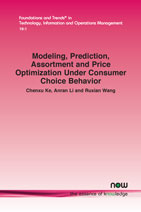Modeling, Prediction, Assortment and Price Optimization Under Consumer Choice Behavior
By Chenxu Ke, Shanghai University of Finance and Economics, China, kechenxu@mail.shufe.edu.cn | Anran Li, CUHK Business School, Hong Kong, anranli@cuhk.edu.hk | Ruxian Wang, Johns Hopkins University, USA, ruxian.wang@jhu.edu
Abstract
Understanding how consumers make choices is of paramount importance, as it offers insights into consumer purchase behavior across multiple products, enables accurate predictions of future demand, and informs strategic planning and policy formulation. The examination of discrete consumer choice models plays a central role in decoding the decision-making process, offering a clear perspective on how individuals navigate among multiple options. These models are instrumental in evaluating a wide range of consumer decisions, such as product selection, brand preference, and the impact of various factors on choice. With the growth of e-commerce and the increasing emphasis on data-driven modeling and decision-making, consumer choice models have garnered significant attention. This rising interest underscores their relevance in the digital marketplace and their contribution to a deeper understanding of consumer behavior. The objective of this work is to present a comprehensive overview of choice modeling, covering both the theoretical underpinnings of widely adopted discrete choice models (e.g., the multinomial logit model), and those integrating contemporary elements like network externalities and ranking effects. It also discusses optimal solutions or efficient approximation heuristics for price and assortment optimization problems, where consumer choice behavior is governed by various discrete choice models. To facilitate practical business applications, this work offers estimation strategies and techniques to address data-related issues. Additionally, it includes cutting-edge advancements such as artificial intelligence and deep learning, and outlines future trends in the realm of operations management with discrete choice models. By delving into the intricate details and mechanisms of these models, this work aims to shed light on the methodological foundations and practical implementations of consumer choice modeling, providing researchers, practitioners, and policymakers with valuable insights into this rich and evolving field.
Modeling, Prediction, Assortment and Price Optimization Under Consumer Choice Behavior
Modeling, Prediction, Assortment and Price Optimization Under Consumer Choice Behavior delves into the intricate relationship between consumer psychology and strategic retail tactics. Drawing on decades of research, the authors explore how factors such as pricing, promotions, and store layout influence shopper behavior in both physical and online settings.
Section 1 provides a historical overview of the evolution of discrete consumer choice modeling and highlights key studies and models in this field. Section 2 delves into the theoretical framework of the most important discrete choice model, the Multinomial Logit (MNL) choice model. Section 3 covers interesting extensions built upon the classic MNL model. Section 4 presents other discrete choice models including the Nested Logit and Mixed Logit models. Section 5 focuses on the pricing problems under the discrete choice models. Section 6 identifies and discusses the challenges of the assortment optimization problems under various consumer choice models. Section 7 focuses on model estimation techniques, such as maximum likelihood estimation and expectation-maximization (EM) algorithm. It also explores the recent advances in discrete consumer choice modeling, including the integration of artificial intelligence and machine learning. Finally, Section 8 points out opportunities for further research and then concludes the work with a summary of the key points and concluding remarks.
